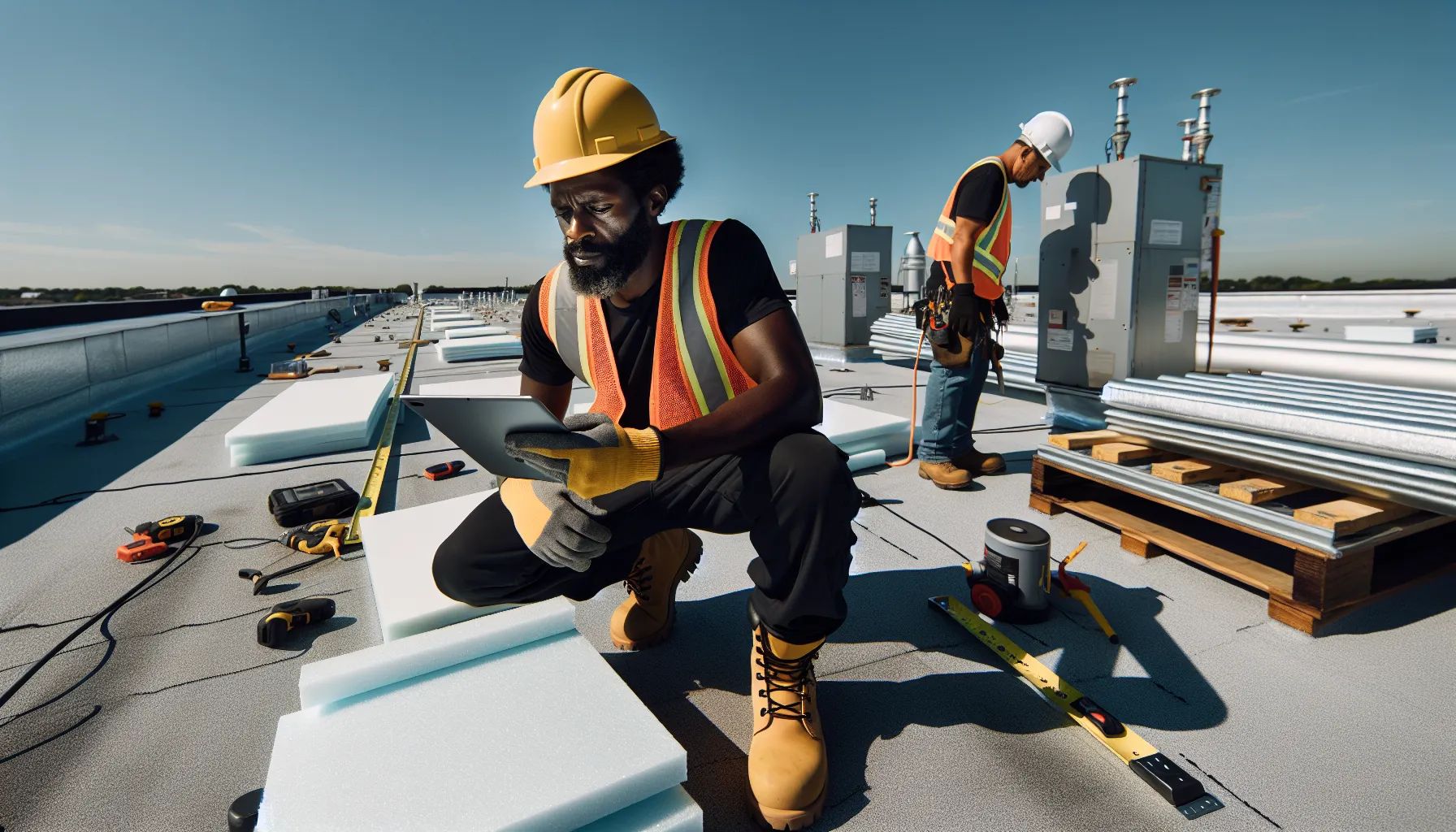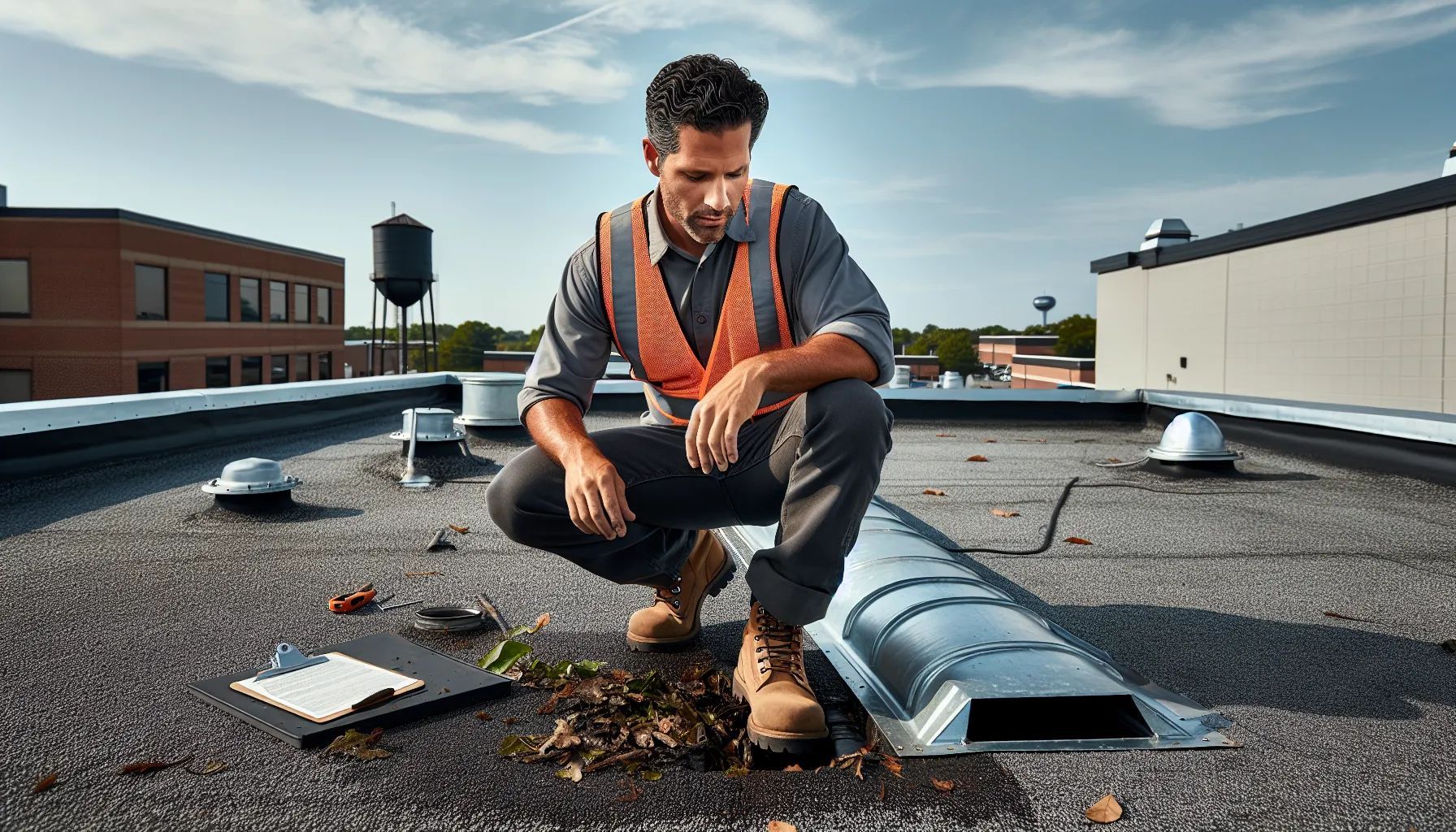Essential Roof Repair Guide: Save Money & Protect Your Home

Your roof protects everything you value most – your family and your home. When roof repair becomes necessary it's crucial to act fast before minor issues turn into costly disasters. We've seen firsthand how a small leak can quickly escalate into thousands of dollars in water damage and structural problems.
Whether you're dealing with missing shingles storm damage or persistent leaks understanding the fundamentals of roof repair can save you time and money. We'll guide you through the essential steps to identify problems choose the right solutions and work effectively with contractors.
From DIY fixes for minor issues to knowing when it's time to call professionals we've compiled everything you need to know. Let's explore the strategies that'll keep your roof in top condition and protect your investment for years to come.
Signs You Need Roof Repair
Recognizing roof damage early prevents costly repairs and protects your home's structural integrity. We've identified key warning signs that indicate your roof requires immediate attention.
Missing or Damaged Shingles
Damaged shingles compromise your roof's protective barrier against weather elements. We inspect roofs for these specific shingle problems:
Damaged shingles compromise your roof's protective barrier against weather elements. We inspect roofs for these specific shingle problems:
Visible Damage Types:
- Cracked shingles with splits longer than 1 inch
- Curled edges lifting more than 0.5 inches from the roof deck
- Missing granules exposing black asphalt underneath
- Completely missing shingles leaving bare spots
Wind speeds exceeding 45 mph commonly cause shingle damage. Hail impacts create circular dents measuring 0.25 to 2 inches in diameter. Temperature fluctuations between 20°F and 90°F cause shingles to expand and contract, leading to cracks.
Age-Related Deterioration:
Asphalt shingles last 15-30 years depending on quality. Three-tab shingles deteriorate faster than architectural shingles. UV exposure breaks down shingle materials over time.
Inspection Areas:
- Roof valleys where two slopes meet
- Areas around chimneys and vents
- Roof edges and corners
- North-facing slopes with less sun exposure
Regular inspections every 6 months help identify shingle damage before it causes leaks. We document damaged areas with photos for accurate repair estimates.
Water Stains and Leaks
Water infiltration creates visible signs inside your home requiring immediate roof repair. We locate leak sources by examining these indicators:
Interior Warning Signs:
- Brown or yellow ceiling stains measuring 6 inches or larger
- Peeling paint or bubbling wallpaper near walls
- Mold growth in attic spaces
- Damp insulation reducing R-value effectiveness
Water travels along rafters before dripping, making leak sources difficult to pinpoint. Attic inspections during rainfall reveal active leaks. We use moisture meters detecting levels above 15% to identify hidden water damage.
Common Leak Locations:
| Area | Frequency |
|---|---|
| Flashing | 35% |
| Valleys | 25% |
| Vents | 20% |
| Skylights | 15% |
| Ridge caps | 5% |
Damage Progression Timeline:
- Day 1-7: Initial water penetration
- Week 2-4: Insulation saturation begins
- Month 2-3: Mold growth starts
- Month 4-6: Structural wood decay
Early leak detection saves thousands in repair costs. We trace water paths from entry points to exit locations for comprehensive repairs.
Sagging Roof Areas
Roof sagging indicates serious structural problems requiring professional evaluation. We assess sagging severity using these measurements:
Sagging Indicators:
- Visible dips exceeding 2 inches over 10-foot spans
- Bowed roof lines visible from ground level
- Interior ceiling cracks following roof contours
- Doors and windows sticking due to frame shifts
Structural causes include undersized rafters, water-damaged decking, and excessive snow loads. Roofs supporting more than 20 pounds per square foot risk sagging. We calculate load capacity based on rafter spacing and lumber dimensions.
Risk Factors:
| Factor | Impact Level | Timeline |
|---|---|---|
| Multiple roof layers | High | 5-10 years |
| Inadequate ventilation | Medium | 10-15 years |
| Original 2x4 rafters | High | 15-20 years |
| Ice dam formation | Medium | 3-5 winters |
Structural Assessment Points:
- Rafter spacing (standard 16-24 inches)
- Decking thickness (minimum 0.5 inches)
- Support beam conditions
- Foundation settling measurements
Sagging roofs pose collapse risks during severe weather. We recommend structural repairs within 30 days of detection. Professional engineers evaluate load-bearing capacity before repair work begins.
Common Types of Roof Damage
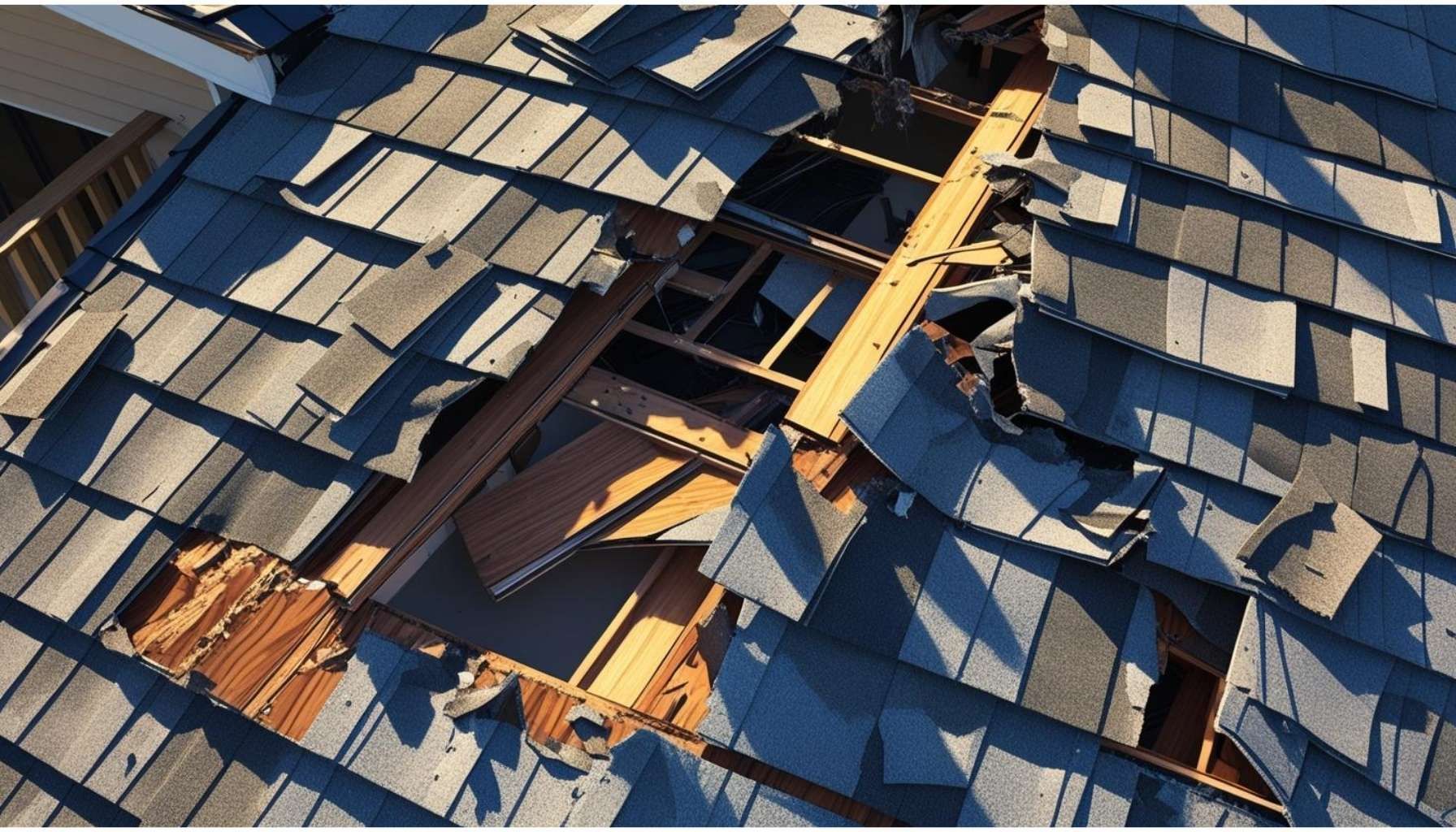
Roofs face damage from multiple sources throughout their lifespan. We identify three primary categories that account for most repair needs: storm impacts, natural aging, and ice dam formation.
Storm and Wind Damage
Severe weather creates immediate threats to roof integrity. High winds exceeding 50 mph can lift shingles and expose underlayment to rain penetration. Hail strikes leave circular indentations measuring 1-2 inches in diameter on asphalt shingles.
Flying debris punctures roofing materials during storms. Tree branches weighing 20-50 pounds crash through shingles and decking when wind speeds reach 70 mph. We find aluminum siding pieces and lawn furniture embedded in roofs after tornadoes.
Wind damage patterns appear along roof edges and ridges first. Corner shingles experience uplift forces three times stronger than center sections. Loose nails allow wind to peel back entire shingle rows.
Rain infiltration follows wind damage within hours. A single missing shingle exposes 1 square foot of underlayment to water. We measure water intrusion rates of 5-10 gallons per hour through damaged sections during heavy rainfall.
Professional storm damage assessment costs $200-400. Insurance claims require documentation within 30 days of storm events. We photograph all visible damage and measure affected areas for accurate repair estimates.
Age-Related Wear
Roofing materials deteriorate predictably over decades. Asphalt shingles lose 3-5% of their granule coating annually from UV exposure. We observe color fading and brittleness after 15 years of sun exposure.
Temperature fluctuations cause 1/8-inch expansion and contraction cycles daily. Shingles crack along stress points after 50,000 thermal cycles. Metal flashings separate from chimney joints when sealants fail after 10-12 years.
| Age-Related Damage Timeline | Years | Signs |
|---|---|---|
| Granule loss begins | 5-7 | Slight color change |
| Edge curling starts | 10-12 | Lifted corners |
| Widespread cracking | 15-18 | Visible splits |
| Complete failure risk | 20-25 | Multiple leaks |
Maintenance extends roof lifespan by 5-10 years. We replace individual shingles showing advanced wear before water penetration occurs. Flashing repairs cost $200-500 versus $2,000-5,000 for water damage restoration.
Regular inspections catch age-related issues early. We examine shingles twice yearly for granule loss and cracking. Professional evaluations every 3-5 years identify hidden deterioration.
DIY vs. Professional Roof Repair
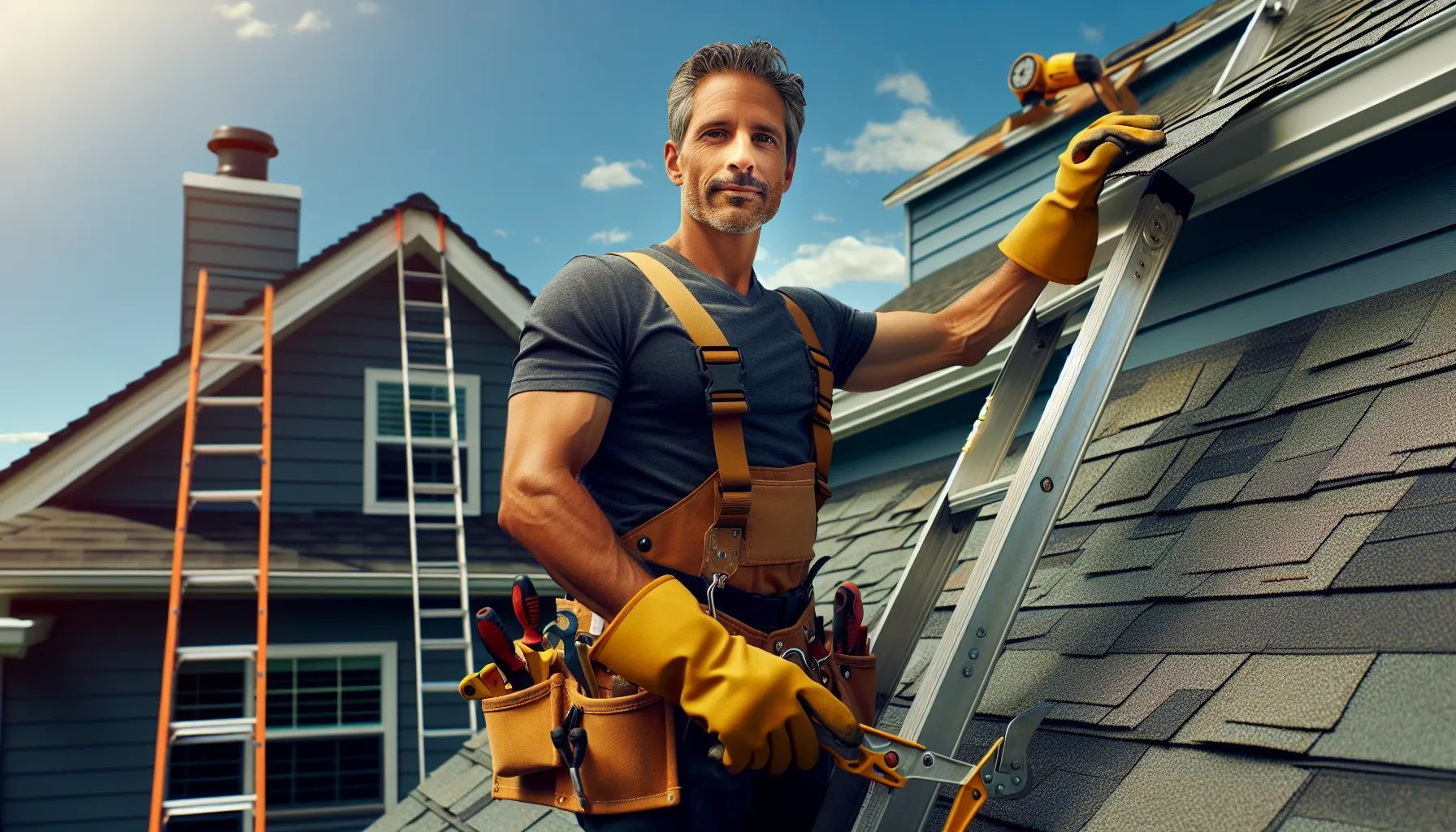
Roof repair decisions depend on damage severity, safety factors, and your repair experience. We'll help you determine when DIY fixes work and when professional contractors provide better value.
When to Tackle Repairs Yourself
DIY roof repair works for minor damage requiring basic tools. Replace 1-3 missing shingles yourself if you're comfortable working 10-15 feet high with proper ladder placement. Clean gutters and remove debris accumulation when weather permits safe roof access.
Budget-conscious homeowners save $200-500 on labor costs for simple repairs. Basic tool requirements include a 20-foot extension ladder, roofing hammer, utility knife, and galvanized roofing nails. Purchase matching shingles from home improvement stores for $25-40 per bundle.
Complete DIY repairs during dry weather with temperatures between 45-85°F. Asphalt shingles become brittle below 45°F and too soft above 85°F. Schedule repairs for morning hours when roof surfaces provide better traction.
Safety equipment costs $50-150 including work gloves, non-slip shoes, and safety harnesses. Avoid DIY repairs on steep roofs exceeding 6:12 pitch ratios. Stop work immediately if you feel unsteady or weather conditions change.
When to Call a Professional
Professional roofers handle complex repairs involving multiple damaged areas or structural concerns. Contact contractors for leaks affecting more than 100 square feet or repairs requiring specialized flashing work. Licensed professionals carry $1-2 million liability insurance protecting your property.
Experienced roofers complete most repairs in 4-8 hours compared to 1-2 days for DIY attempts. Professional crews bring commercial-grade equipment including pneumatic nail guns, metal brakes for custom flashing, and 40-foot ladders. Material costs decrease 20-30% through contractor wholesale accounts.
Storm damage assessments require professional expertise to document insurance claims properly. Contractors identify hidden damage patterns missed by untrained eyes. Professional repairs include 1-5 year workmanship warranties covering installation defects.
Structural repairs demand professional intervention including sagging decking, damaged trusses, or compromised load-bearing elements. Contractors coordinate with structural engineers when repairs exceed standard roofing scope. Professional teams handle permit applications and code compliance requirements efficiently.
Roof Repair Methods and Materials
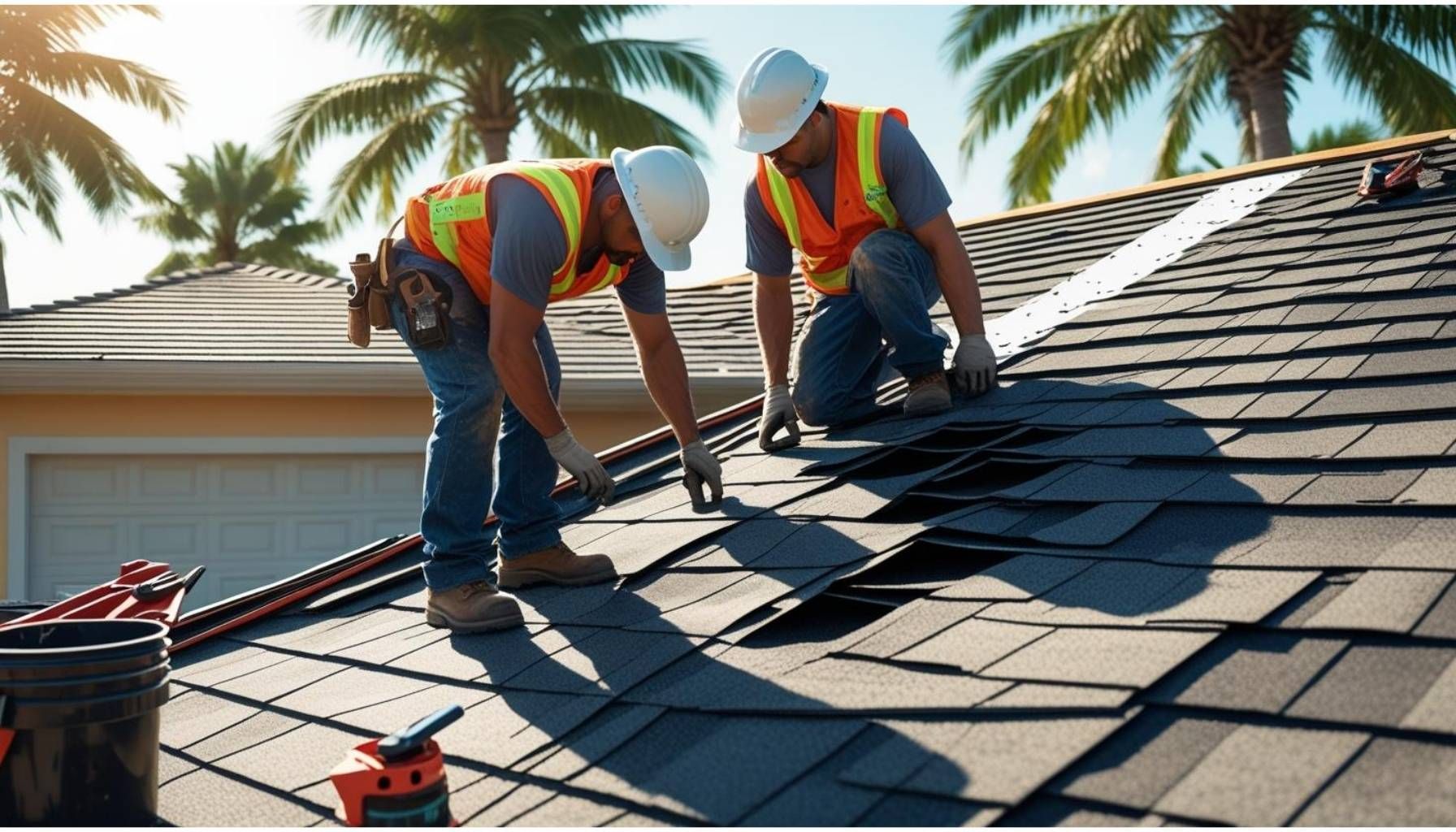
Roof repair methods vary based on damage type and severity. We'll explore essential techniques and materials that restore your roof's integrity and extend its lifespan.
Shingle Replacement Techniques
Shingle replacement starts with removing damaged shingles carefully. We use a pry bar to lift the damaged shingle and surrounding shingles to access the nails underneath. The area gets cleaned thoroughly before installing new shingles.
New shingles align with existing ones for proper water drainage. We secure each shingle with four roofing nails placed 1 inch from the edges and 5.5 inches from the bottom edge. Roofing cement seals the nail heads and shingle edges.
Temperature affects shingle installation success. We perform replacements when temperatures range between 40°F and 85°F. Cold shingles crack easily while hot shingles tear during handling.
Matching shingle color and style maintains your roof's appearance. We keep spare shingles from original installation or find closest matches through manufacturer codes. Asphalt shingles cost $100-$200 per square (100 square feet) for materials.
Flashing and Sealant Repairs
Flashing repairs prevent water penetration around roof penetrations. We inspect flashing around chimneys, vents, skylights, and valleys for rust, cracks, or separation. Damaged sections require immediate attention to prevent leaks.
Small flashing repairs involve applying roofing cement to gaps and cracks. We clean the area with a wire brush, apply primer if working with metal flashing, then seal with roofing cement. The cement extends 2 inches beyond the damaged area.
Complete flashing replacement becomes necessary when damage exceeds 25% of the section. We remove old flashing, install ice and water shield underneath, then secure new flashing with roofing nails every 12 inches. Step flashing pieces overlap by 2 inches minimum.
Sealant selection depends on the repair location. We use polyurethane sealants for metal-to-metal connections and silicone sealants for areas with high UV exposure. EPDM liquid rubber works excellently for flat roof repairs, creating waterproof membranes that last 10-15 years.
Structural Repairs
Structural repairs address compromised roof support systems. We identify weak spots through sagging areas, cracked rafters, or water-damaged decking. These repairs require immediate professional attention to prevent collapse.
Reinforcing weak areas involves installing sister rafters alongside damaged ones. We use 2x6 or 2x8 lumber matching existing rafter dimensions. The sister rafters extend 2 feet beyond damage on each side, secured with 3-inch screws every 16 inches.
Decking replacement becomes essential when plywood or OSB shows rot or delamination. We remove damaged sections, inspect underlying rafters, then install new 5/8-inch plywood or 7/16-inch OSB. Each sheet gets secured with 8d nails every 6 inches along edges and 12 inches in the field.
Mesh reinforcement strengthens large damaged areas without full replacement. We apply roofing cement, embed fiberglass mesh, then cover with additional cement. This method costs $3-$5 per square foot compared to $7-$10 for complete decking replacement.
Choosing a Roof Repair Contractor
Selecting the right roof repair contractor protects your investment and ensures quality workmanship. We'll guide you through essential credentials and critical questions to ask before hiring.
Credentials to Look For
Licensing and insurance form the foundation of contractor credibility. Verify the contractor holds a valid state license and carries liability insurance plus workers' compensation coverage. These documents protect you from financial responsibility if accidents occur during repairs.
Professional certifications demonstrate advanced training and expertise. GAF Master Elite certification, for example, indicates contractors completed specialized training and maintain high standards. Certified contractors often provide extended manufacturer warranties on materials.
Permanent business location confirms contractor stability. Check for a physical address, working phone number, and tax identification number. Established contractors maintain consistent contact information for accountability.
Industry association memberships signal professional commitment. National Roofing Contractors Association (NRCA) members follow industry best practices and ethical standards. Association membership requires ongoing education and adherence to quality guidelines.
Written warranties protect your repair investment. Reputable contractors offer clear warranties covering materials and workmanship for specific timeframes. Material warranties typically last 20-50 years while workmanship warranties range from 2-10 years.
References and portfolio validate contractor experience. Request contact information for three recent clients with similar repairs. Review photos of completed projects matching your roof type and repair scope.
Questions to Ask Before Hiring
"Are you licensed and insured?" Request copies of current license and insurance certificates. Verify coverage amounts meet local requirements and confirm policies remain active throughout your project.
"What certifications do you hold?" Certified contractors access premium materials and extended warranties. Manufacturer certifications require ongoing training and quality standards compliance.
"What experience do you have with my roof type?" Asphalt shingle repairs differ from tile or metal roofing work. Contractors experienced with your specific material understand proper installation techniques and potential challenges.
"Can you provide references from similar projects?" Contact provided references to confirm work quality, timeline adherence, and communication effectiveness. Ask references about unexpected issues and contractor response.
"What warranties come with the repair?" Understand warranty coverage duration and exclusions. Material warranties cover manufacturing defects while workmanship warranties address installation errors. Clarify maintenance requirements that preserve warranty validity.
"How will you supervise the project?" Identify the project supervisor and quality control process. Professional contractors assign experienced supervisors who inspect work at completion stages.
"Do you provide detailed written estimates?" Written proposals specify repair scope, materials, timeline, payment schedule, and total cost. Compare multiple estimates for comprehensive understanding of project requirements and fair pricing.
Preventing Future Roof Damage
We protect our roofs through consistent maintenance and early intervention. Our preventive measures reduce repair costs by 30-50% and extend roof lifespan significantly.
Regular Maintenance Tips
We inspect our roofs twice yearly during spring and fall seasons. Our examination focuses on loose shingles, cracked tiles, damaged flashing, and moss growth. We clean gutters at least twice per year to prevent water backup beneath shingles. Debris removal from roof surfaces prevents moisture buildup that causes rot and mold formation.
We apply protective coatings to roofing materials every 3-5 years. These coatings shield against UV rays and heat damage while increasing material durability. We trim overhanging branches within 10 feet of our roof to prevent damage from falling limbs and reduce leaf accumulation in gutters.
Our attic inspections reveal early signs of water damage before exterior symptoms appear. We check for proper ventilation to prevent moisture buildup and temperature extremes. Professional inspections complement our routine maintenance when we discover potential issues beyond our expertise.
Seasonal Inspection Checklist
Spring inspections focus on winter damage assessment. We clear accumulated debris and examine flashing for freeze-thaw cracks. Our checklist includes checking seals around chimneys and vents for deterioration.
Summer preparations involve examining shingles for heat damage like curling or blistering. We prepare for storm season by securing loose materials and reinforcing vulnerable areas.
Fall maintenance centers on gutter cleaning from fallen leaves. We verify attic ventilation functions properly before winter moisture challenges arrive. Missing or broken shingles receive immediate attention before cold weather sets in.
Winter monitoring requires checking for ice dam formation along roof edges. We inspect after heavy snowfall events, particularly around skylights and chimneys where snow accumulation creates extra stress. Prompt snow removal from vulnerable areas prevents structural strain and water infiltration.
Conclusion
We've covered the essential aspects of roof repair that'll help you protect your home's most critical defense system. Whether you're dealing with storm damage or age-related wear you now have the knowledge to make informed decisions about your roof's care.
Remember that proactive maintenance isn't just about saving money—it's about ensuring your family's safety and comfort. By implementing regular inspections and addressing minor issues promptly you'll extend your roof's lifespan significantly while avoiding emergency repairs.
We encourage you to take action today. Schedule that overdue inspection check your attic for signs of moisture or contact a qualified contractor for concerning issues you've noticed. Your roof works hard to protect everything beneath it and with proper attention it'll continue doing so for years to come.
The investment you make in roof maintenance today will pay dividends tomorrow through lower repair costs improved energy efficiency and enhanced home value. Don't wait until a small problem becomes a major headache—your home deserves the protection that comes from a well-maintained roof.
What are the main signs that my roof needs repair?
The primary indicators include missing or damaged shingles, water stains on ceilings, visible leaks during rain, and sagging roof areas. Also watch for granule loss in gutters, daylight through roof boards, and excessive energy bills. If you notice any of these signs, schedule an inspection promptly to prevent costly damage.
How much does roof repair typically cost?
Roof repair costs range from $150 to $8,000, with most homeowners spending around $1,150. Asphalt shingle repairs cost $3-$7 per square foot, while slate repairs can reach $12-$25 per square foot. Factors affecting price include material type, roof complexity, geographic location, and repair urgency.
Should I attempt DIY roof repair or hire a professional?
DIY repairs work for minor issues like replacing a few shingles or applying sealant. However, hire professionals for complex repairs, significant leaks, structural damage, or when safety is a concern. Licensed contractors provide warranties, identify hidden damage, and handle insurance claims properly.
How often should I inspect my roof?
Inspect your roof twice yearly, ideally in spring and fall. Additionally, check after severe weather events like storms or heavy snowfall. Regular inspections help catch problems early, potentially reducing repair costs by 30-50% and extending your roof's lifespan.
What credentials should I look for in a roofing contractor?
Verify the contractor has proper licensing, liability insurance, and workers' compensation coverage. Look for professional certifications, permanent business location, and industry association memberships. Ask about their experience with your roof type, warranty terms, and whether they'll supervise the project personally.
